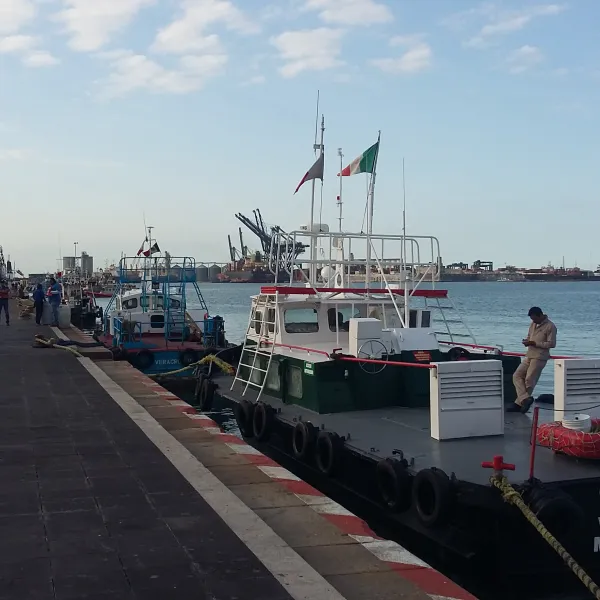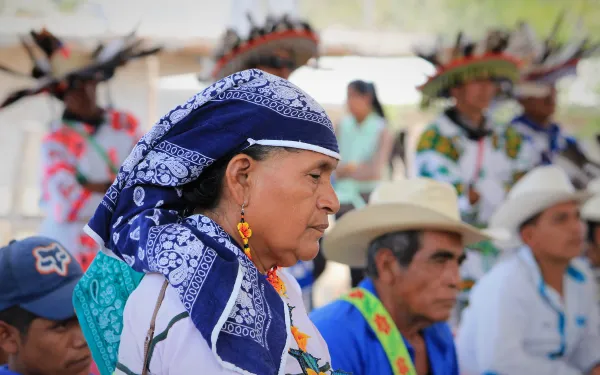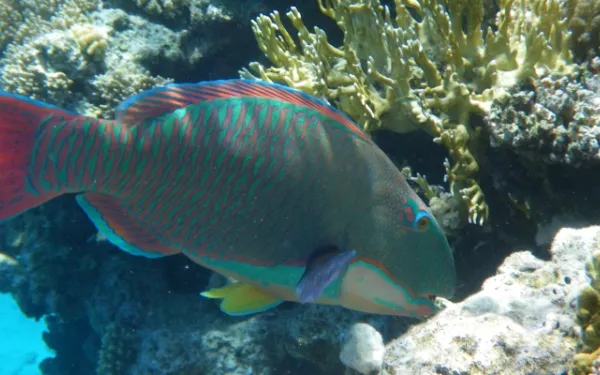
Project
Photo: Manuel VictoriaDefending the Veracruz Reef from a port expansion project
In the Gulf of Mexico, 27 coral reefs form a submarine mountain range running for miles between six islands. Hundreds of colorful fish species, sea urchins, starfish, and sea grasses share the reef with an abundance of other life forms. Fishing, sport diving, and beach tourism thrive along the coast. This is the magnificent Veracruz Reef, the largest coral ecosystem in the Gulf.
In 1992, Mexico’s government declared the Veracruz Reef System a Natural Protected Area. In 2004, it was listed as a Wetland of International Importance under the Ramsar Convention, a treaty for the protection of wetlands including reefs.
Despite the reef’s recognized significance, in 2013 the government reduced the size of the Natural Protected Area and approved a port expansion project. Local communities and organizations challenged the project's environmental permits, demanding protection of the right to a healthy environment.
On February 9, 2022, the Supreme Court of Justice of the Nation unanimously decided that the authorities violated the right to a healthy environment of Veracruz residents by authorizing the port expansion based on a fragmented environmental impact assessment. This means that the permits for the project are non-existent and that the impacts of the project on the health of the reefs must be studied again, this time in a comprehensive manner, and even the viability of the project.
The ruling is a historic precedent not only in Mexico, but for the entire region, as it allows access to environmental justice for the people neighboring an ecosystem affected by a project.
Partners:

Related projects

The shortsighted expansion of the Port of Veracruz
The powers behind the Port of Veracruz expansion project share a trait all too common in Mexico: a vision of development as the sum of short-term gains. But achieving those often requires squashing all possible obstacles, including our natural environments and the laws that protect them. “The first stage of the expansion of the Port of Veracruz will provide oxygen to the surrounding area for 15 or 20 years,” stated Juan Ignacio Fernández Carbajal, director of the Veracruz Port Authority. By oxygen, the director means economic income and new sources of employment derived from the port’s increased capacity. But this vision of development—so clearly shortsighted— ignores the social, environmental and economic benefits that the Veracruz Reef System has long provided, and which it will continue to provide for far more than 20 years. The second most important infrastructure project in Mexico’s recent history will irreversibly damage the largest coral ecosystem in the Gulf of Mexico, the Veracruz Reef System National Park. The reefs of Veracruz provide oxygen to Mexico and our planet in the most literal sense. The oceans and their ecosystems, particularly coral reefs, generate about half the oxygen we breathe and absorb almost a third of the carbon dioxide we emit. Coral reefs also produce 17 percent of all proteins consumed worldwide—a percentage that rises to 70 percent for coastal nations, according to a report by the United Nations Food and Agriculture Organization. They harbor more than 100 thousand different species of marine fauna, including thousands of commercial fish, which share their home with herbivorous fish, sea turtles and sharks. In good conditions, reefs protect coastal populations from storms, hurricanes and tsunamis—natural phenomena aggravated by climate change. They absorb up to 95 percent of the impact of waves generated by strong winds. The people of Veracruz know particularly well how the reefs have protected them. When hurricane Karl (a category four) hit the city in 2001, the Veracruz reefs provided a buffer that protected the city from the worst of the storm. Despite the fact that the reef system was designated a national protected area in 1975, and named a national park in 1992, the government decided to change the park’s boundaries in 2012 to allow for the expansion of the Port of Veracruz—effectively excluding the Punta Gorda reefs and Vergara Bay from the protected area. In purely economic terms—those clearly prioritized by the project’s promoters—by taking away the protection of those reefs, and putting their future at risk, Mexico’s oceans are losing value. The value of the environmental services provided by the now-unprotected Punta Gorda and Vergara Bay reefs is estimated around $290.5 million USD, a dramatic figure in light of the estimated value of the expanded port's activities. The port expansion project has an estimated value of $85,600 USD per square kilometer, according to an article by the University of Veracruz, a figure that pales in comparison to the estimated value of ecosystem services provided by coral reefs, which ranges between $100,000 and $600,000 USD dollars per square kilometer, according to the United Nations Environment Program. The obligations Mexico ignored to promote the port “Unfortunately, when we thought the project was about to begin, we began to have environmental problems, which delayed the project for about three and a half years,” Fernández Carbajal explained. The “problems” to which the director is referring is the existence of protected coral reefs on site. “Since the problem was a national park, the government figured they’d remove it from the area so they could build the port without facing any legal obstacles,” Leonardo Ortiz, a researcher at the University of Veracruz, explained in our documentary short Battle for the Reefs of Veracruz. According to national law, the only activities permitted within the Veracruz Reef System National Park are those related to the protection of its natural resources, the increase in flora and fauna, and the preservation of its ecosystems and their elements. Port activities are clearly in violation of this law. So rather than stop the expansion project, the government chose instead to change the park’s boundaries, effectively unprotecting the reefs that fell within the port’s proposed limits. In doing so, the government failed to conserve the natural characteristics of the nation’s ecosystems for future generations. It also violated its obligations under the Ramsar Convention, an intergovernmental treaty for the protection of wetlands, under which the Veracruz Reef System is recognized as a Wetland of International Importance. What’s more, the project’s Environmental Impact Assessment was highly flawed in the following ways: The Port Authority requested a fragmented authorization of the project, which prevented an adequate and comprehensive assessment of the project’s cumulative impacts over time. By ignoring the existence of the once-protected reef located in the construction zone, the assessment failed to provide the best possible scientific data. It did not include protective measures for sea turtles that spend an important part of their life cycle in the park—particularly hawksbill turtles, a threatened species recognized by the Inter-American Convention for the Protection and Conservation of Sea Turtles. It failed to consider the impacts on the reef due to sedimentation, the dredging of the Bay of Vergara and Punta Gorda, and the increase in the quantity and size of the vessels in the new port. It ignored the fact that, by transporting an increased quantity of hydrocarbons, the port’s expansion increases the risk of spills in a region highly vulnerable to these incidents, which could seriously damage the highly biodiverse reef system in the Southeast corridor of the Gulf of Mexico. For all of the above reasons, residents of the city of Veracruz have filed a writ of amparo, denouncing the government’s blatant violations of human rights and environmental law. In the legal action—presented by the Mexico Center for Environmental Law (CEMDA) and supported by AIDA—residents attest that the port expansion project is violating their human right to a healthy environment. The question we must consider then, is this: Does the short-term economic advancement of a region matter more than the preservation of a 10,000-year-old reef system that guarantees biodiversity, sustainable tourism, food security, and enduring protection against climate change? For those of us who think of the long game, and consider the natural world to be our best ally on the path toward a sustainable future, the answer is clear. The port expansion must be stopped.
Read more
Supporting Mexico’s indigenous communities in their fight against Las Cruces Dam
AIDA filed an amicus brief demonstrating the international environmental and human rights obligations the Mexican government violated by authorizing the controversial hydroelectric project. It was written in support of a lawsuit filed by the Wixárika people of Nayarit, Mexico, whose land and sacred sites would be affected by the dam. Nayarit, Mexico. The Inter-American Association for Environmental Defense (AIDA) presented an amicus brief before the First District Court of Nayarit, demonstrating the international environmental and human rights obligations the Mexican government violated by authorizing the Las Cruces hydroelectric project. The brief supports the writ of amparo filed against the project by members of the Wixárika indigenous community. "When analyzing the project, Mexican authorities failed to adequately consult affected communities and obtain their free, prior, and informed consent. Above all, they failed to respect their rights to self-determination, autonomy, territory and cultural identity, and to a healthy environment," explained AIDA attorney Camilo Thompson. "In addition, authorities overlooked the risks of damage to the San Pedro Mezquital river basin and the ecosystem it feeds: the mangrove forests of Marismas Nacionales, an internationally protected site." The hydroelectric plant, promoted by the Federal Electricity Commission, threatens ceremonial sites on which the spiritual life of the Wixárika, Náyeris-Cora, Tepehuano and Mexicanero people depend. Members of the Wixárika tribe presented the demand for protection (amparo) in mid-2017 against the authorities that endorsed the project—the Ministry of Environment and Natural Resources and the National Water Commission. AIDA’s supporting brief, presented in March, details the international obligations Mexico breached by approving the dam—those contained in the American Convention on Human Rights, the Protocol of San Salvador, Convention 169 of the International Labor Organization on indigenous and tribal peoples in independent countries, the Convention on Biological Diversity, the Ramsar Convention on Wetlands of International Importance, and the United Nations Framework Convention on Climate Change. After the request for protection was filed, the court ordered the suspension of project permits until the legal process has concluded and a decision has been made as to whether those permits are valid. Government authorities have argued that the project must continue because it is in the public interest, and that indigenous peoples can "re-organize their spiritual life in a context modified by the project’s construction." This position ignores the rights of communities, due process, and the environmental threats affecting the public interest. In order to safeguard the rights of affected communities, the court must now continue the legal process, confirm the project’s suspension, and issue the cancellation of all related permits. “The government must maintain the balance between the protection of human rights and the environment, thereby canceling the permits granted to the Las Cruces project and protecting the rights of the affected communities," Thompson said. "In this instance, Mexico has the opportunity to strengthen the global trend towards truly sustainable energy, moving away from large dam projects that emit greenhouse gases and aggravate climate change." Learn more about the case here. Press contact: Camilo Thompson, AIDA attorney, +521 9671302346, [email protected]
Read more
To keep corals healthy, we must protect herbivorous fish
We all know coral reefs are fragile environments, highly vulnerable to climate change and pollution. But did you know they also had to compete for light and oxygen with the tiny macro-algae that cover their surface? That’s why some of corals' best friends are herbivorous fish—species like parrotfish and surgeonfish that feed on algae, helping to keep corals healthy. But in the Caribbean, unsustainable fishing practices are causing a decline in populations of parrotfish (and other herbivorous fish), putting the health of corals at risk. That’s why, in AIDA’s marine program, we’re launching a large-scale project dedicated to the conservation of herbivorous fish throughout Latin America—focused on the nations of Colombia, Costa Rica, Guatemala, Honduras, Mexico and Panama. Herbivorous fish conservation The parrotfish is one of the most important fish living in coral reefs. They spend most of the day nibbling on corals, cleaning algae from their surface. They also eat dead corals—those bits and pieces that protrude from the reef—and later excrete them as white sand. A key element to maintaining sustainable fisheries is catching only adult fish—those that have already matured and reproduced. But in the Caribbean right now, people are fishing juvenile parrotfish. Though not a commercial species, parrotfish are being captured because they’re some of the only fish left in the reef. The irresponsible nature of commercial fishing in the region has caused a drastic decline in both commercial and herbivorous fish. “A key element of maintaining a sustainable fishery is catching only adult fish, which have already matured and reproduced. But what’s happening in the Caribbean is the fishing of young parrotfish,” explained Magie Rodríguez, AIDA marine attorney. Most fishing is done with gillnets and hooks, which cause high levels of by-catch—unwanted populations of marine species caught in commercial fishing. Harpoons and traps are also used, which prevent younger, smaller fish from escaping and continuing their life cycle. Surgeonfish and damselfish are two other herbivorous fish—both small and quite beautiful—falling victim to irresponsible fishing practices. Their popularity in tropical home aquariums has led to a decline in their wild populations. Remember Dory, from Finding Nemo? She was a surgeonfish, and the movie’s popularity led to an increased demand for her species in aquariums. What the movie didn’t tell you is that the surgeonfish’s small, sharp teeth are highly adept at chewing algae, preventing the plantlife from essentially choking coral reefs of oxygen and light. Conservation strategies AIDA’s project for the conservation of herbivorous fish in the Caribbean is in its initial phases. Our objective is the implementation of diverse strategies, across the six Latin American nations, to protect these fish and, by extension, the reefs they call home. “To restore the balance of the coral ecosystem, it’s necessary to achieve the recovery not just of herbivorous fish populations, but also of commercial species,” Rodríguez said. So we’re talking not just about fishing bans, but also about the general adoption of sustainable fishing tools that take into account the tourism potential of coral reefs. The project will also contemplate adequate wastewater management strategies, consumer education, and collaboration between governments, NGOs, universities and scientists. Corals are, among other things, a source of economic income and food for coastal communities that live from fishing and tourism. Plus, they are natural barriers against storms and hurricanes. “Corals do a lot for us and we have to take care of them,” Rodríguez added. “We’ve come to find that the best thing we can do to keep corals healthy is to protect the herbivorous fish that call them home.”
Read more